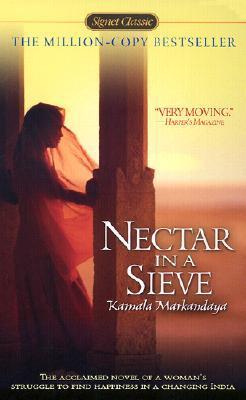Nectar in a Sieve Book Summary
TL;DR
Nectar in a Sieve by Kamala Markandaya is a poignant tale of Rukmani, a child bride, who valiantly faces the challenges of poverty and societal change in rural India while striving to protect her family.
What is Nectar in a Sieve about
Set in a drought-stricken village in India, Nectar in a Sieve follows Rukmani, who is married at twelve to Nathan, a tenant farmer. The novel vividly depicts their struggles against nature's wrath and societal injustices as they navigate the complexities of rural life. Through Rukmani's journey, Markandaya explores themes of resilience, love, and the clash between tradition and progress. The backdrop of changing times—highlighted by the establishment of a tannery that disrupts their lives—serves as a stark reminder of the forces impacting the lives of the impoverished. This narrative is not only a portrayal of survival but also an exploration of the human spirit's capacity for hope amidst despair.
Nectar in a Sieve 5 Key Takeaways
Rukmani's early life and marriage.
Rukmani, a young girl, is married off to Nathan, a tenant farmer, at the tender age of twelve. This arranged marriage sets the stage for her journey through life, where she learns to navigate the hardships of rural existence.
The struggles of farming life.
Rukmani and Nathan toil together on the land, battling droughts, floods, and pests. Their efforts symbolize resilience and the deep connection between the family and the land they cultivate.
The arrival of the tannery.
The establishment of a tannery in their village brings new challenges, disrupting the traditional way of life and exacerbating poverty. This reflects the broader theme of industrialization and its impact on rural communities.
The impact of poverty on family.
As poverty deepens, Rukmani's family faces a series of hardships, including the loss of their children, which serves to illustrate the relentless struggle against an unforgiving world.
Rukmani's resilience and strength.
Throughout her life, Rukmani embodies the spirit of perseverance, demonstrating extraordinary fortitude in the face of loss and adversity, ultimately clinging to her hopes for her family.
Top Nectar in a Sieve Quotes
- Life is a struggle, and it has its moments of joy, but it is the struggle that defines us.
- In the depth of despair, one finds the strength to endure.
Who should read Nectar in a Sieve?
Nectar in a Sieve is ideal for readers interested in poignant narratives that explore resilience and the human condition. It appeals to those who appreciate rich cultural contexts and the complexities of rural life in India, particularly in the face of societal change.
Nectar in a Sieve Best Reviews
- The New York Times praised Nectar in a Sieve for its 'lyrical prose' and the profound emotional depth of Rukmani's character, making it a timeless depiction of human endurance.
- The Associated Press highlighted the novel as a heart-wrenching narrative, emphasizing Markandaya's ability to evoke empathy through Rukmani's poignant journey.
People also liked these summaries
Nectar in a Sieve FAQs
What is the main theme of Nectar in a Sieve?
The main theme revolves around the struggle for survival in the face of poverty and societal change, highlighting the resilience and fortitude of a woman navigating through life's adversities.
How does the novel address gender roles?
Nectar in a Sieve critically examines gender roles, showcasing Rukmani’s strength and resourcefulness while highlighting the limitations imposed on women in a patriarchal society.
